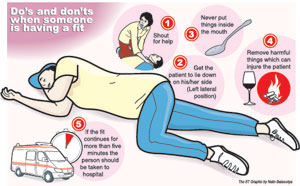Facts and Fallacies About Epilepsy
Philippine League Against Epilepsy, in celebration of National Epilepsy Awareness Week last September 1 - 6, 2014 shared some facts and fallacies about Epilepsy that would help us to fully understand Epilepsy.
 |
| Image Source |
1. It is a mental condition and leads to insanity.
FACT: Epilepsy is a brain condition characterized by recurrent seizures. Seizures are sudden, brief abnormalities of behavior, thought, movement or sensation generally lasting for a few minutes. Seizures are caused by a hyperactive, disorganized electrical activity from the brain.
Although psychosis may be found in only 2-7% of persons with epilepsy, it is the exception rather than the rule.
2. It is caused by spirit possession or “pagsasapi”.
FACT: Although movies, literature and folklore refer to seizures as arising from a spirit possession because of some similarities in their manifestations, seizures can be documented scientifically as abnormal brain activity on EEG, unlike demon possession.
Seizures are not dealt with by exorcism or prayer; only by medications and in other cases, brain surgery and a special diet (ketogenic diet, doctor prescribed).
3. It is contagious or can be inherited.
In the past decades, this fallacy has caused many patients with epilepsy to be shunned from society and from pursuing marriage and
FACT: Many conditions can cause epilepsy. In a small number of patients (10-15%), the susceptibility or predisposition to develop seizures may be inherited. However, for the most number of patients, it can be due to other brain insults. It may happen in those with a history of head injury. It may also happen to those with hypoxic brain injury sustained from a birth complication ( lack of brain oxygen in the baby during child birth – ex. due to coiled cord around neck of baby, difficult labor, maternal complications leading to fetal distress). It may also result from an infection of the brain (meningitis, encephalitis), brain tumors, strokes, prolonged convulsions in childhood. The cause may be unknown in around 40% of cases.
This leads us to another interesting question:
4. Can Epilepsy be Prevented?
Many cases of epilepsy can be prevented by wearing seat belts and bicycle helmets, putting children in car seats, and other measures that prevent head injury and other trauma. Prescribing medication after first or second seizures or febrile seizures also may help prevent epilepsy in some cases. Good prenatal care, including treatment of high blood pressure and infections during pregnancy, can prevent brain damage in the developing baby that may lead to epilepsy and other neurological problems later.
Treating cardiovascular disease, high blood pressure, infections, and other disorders that can affect the brain during adulthood and aging also may prevent many cases of epilepsy. Finally, identifying the genes for many neurological disorders can provide opportunities for genetic screening and prenatal diagnosis that may ultimately prevent many cases of epilepsy.
5. Epilepsy patients are retarded.
FACT: This is a misperception because epilepsy is highly prevalent among other disability groups such as autism (25.5%), cerebral palsy (13%), Down syndrome (13.6%) and mental retardation (25.5%). However, if one looks at the entire population of people suffering from epilepsy, majority of them have normal IQs, are able to go to school and sustain gainful employment.
6. Patients with epilepsy shouldn’t get stressed so they should not study or work or indulge in sports and leisure activity.
FACT: The relationship between the occurrence of psycho-mental stress and seizures is at present unstudied. Patients associate stressful periods with an increase in seizures. Many experts believe it is the effects of stress such as disturbed sleep and missing meals and medications that bring about an increase in seizures rather than the psychological or mental preoccupation itself.
The fact that there are philosophers, world leaders, artists, writers, politicians and athletes who have epilepsy prove that epilepsy should not pose a limitation to mental and physical activities.
7. Patients with epilepsy shouldn’t get married because they might pass on their epilepsy to their children. (See above on epilepsy and inheritance.)
8. When a patient starts to have a seizure, the best first aid is to stick a spoon inside
FACT: When a person goes into a seizure, there are very powerful muscle contractions that suddenly cause him to fall, stop breathing, bite his tongue and clamp his jaw.
Inserting an object into his mouth has been found to be more detrimental to the patients and has caused dental fractures, mouth lacerations and suffocation. It is not encouraged.
Rather, one should:
1) Cushion the patient’s head with a soft pillow.
2) Loosen his clothing around the neck.
3) Remove harmful objects around him which can hurt or injure him.
4) Turn him to his side to prevent suffocation and allow drainage of saliva.
5) Time the seizures. If seizures last 5 minutes or more or the patient has been injured, the patient should be brought immediately to the emergency room.
 |
| Image Source |
for a long time.
FACT: Epilepsy is a chronic condition and needs long term intake of antiepileptic drug, the minimum of which is 2-5 years, depending on its cause. Patients are always advised to take their medications daily to prevent seizures from recurring each day. There are minor side effects with long term intake, esp. on the bone, cognition, blood elements or liver but these can be monitored by the doctor on regular follow-up.
 |
| Image Source |



0 comments